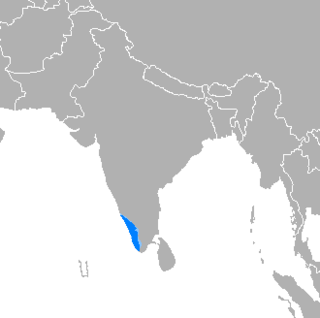
In cryptography, a cipher is an algorithm for performing encryption or decryption—a series of well-defined steps that can be followed as a procedure. An alternative, less common term is encipherment. To encipher or encode is to convert information into cipher or code. In common parlance, "cipher" is synonymous with "code", as they are both a set of steps that encrypt a message; however, the concepts are distinct in cryptography, especially classical cryptography.

Malayalam is a Dravidian language spoken in the Indian state of Kerala and the union territories of Lakshadweep and Puducherry by the Malayali people. It is one of 22 scheduled languages of India. Malayalam was designated a "Classical Language of India" in 2013. Malayalam has official language status in Kerala and Puducherry (Mahé), and is also the primary spoken language of Lakshadweep and is spoken by 34 million people in India. Malayalam is also spoken by linguistic minorities in the neighbouring states; with a significant number of speakers in the Kodagu and Dakshina Kannada districts of Karnataka, and Kanyakumari and Nilgiris district of Tamil Nadu. It is also spoken by the Malayali Diaspora worldwide, especially in the Persian Gulf countries, due to the large populations of Malayali expatriates there. They are a significant population in each city in India including Mumbai, Bengaluru, Delhi, Kolkata, Pune etc.

Kottayam is one of 14 districts in the Indian state of Kerala. Kottayam district comprises six municipal towns: Kottayam, Changanassery, Pala, Erattupetta, Ettumanoor, and Vaikom. It is the only district in Kerala that neither borders the Arabian Sea nor any other states.

The Kingdom of Travancore, also known as the Kingdom of Thiruvithamkoor, was an Indian kingdom from c. 1729 until 1949. It was ruled by the Travancore Royal Family from Padmanabhapuram, and later Thiruvananthapuram. At its zenith, the kingdom covered most of the south of modern-day Kerala and the southernmost part of modern-day Tamil Nadu with the Thachudaya Kaimal's enclave of Irinjalakuda Koodalmanikyam temple in the neighbouring Kingdom of Cochin. However Tangasseri area of Kollam city and Anchuthengu near Attingal in Thiruvananthapuram were parts of British India. Bordering the kingdom were the five Tamil-majority Taluks of Madras Presidency to the north, Madurai and Tirunelveli districts of Pandya Nadu region in Madras Presidency to the east, the Indian Ocean to the south, and the Arabian Sea to the west. As of the 1911 Census of India, Travancore was divided into five: Padmanabhapuram, Trivandrum, Quilon, Kottayam, and Devikulam, of which the first and last were predominantly Tamil-speaking areas.

Malayalam script is a Brahmic script used commonly to write Malayalam, which is the principal language of Kerala, India, spoken by 45 million people in the world. It is a Dravidian language spoken in the Indian state of Kerala and the union territories of Lakshadweep and Puducherry by the Malayali people. It is one of the official scripts of the Indian Republic. Malayalam script is also widely used for writing Sanskrit texts in Kerala.

The Malayalam Calendar is a sidereal solar calendar used in Kerala. The origin of the calendar has been dated to 825 CE, the beginning of the Kollam Era.
Indian Standard Code for Information Interchange (ISCII) is a coding scheme for representing various writing systems of India. It encodes the main Indic scripts and a Roman transliteration. The supported scripts are: Bengali–Assamese, Devanagari, Gujarati, Gurmukhi, Kannada, Malayalam, Oriya, Tamil, and Telugu. ISCII does not encode the writing systems of India that are based on Persian, but its writing system switching codes nonetheless provide for Kashmiri, Sindhi, Urdu, Persian, Pashto and Arabic. The Persian-based writing systems were subsequently encoded in the PASCII encoding.
The International Alphabet of Sanskrit Transliteration (IAST) is a transliteration scheme that allows the lossless romanisation of Indic scripts as employed by Sanskrit and related Indic languages. It is based on a scheme that emerged during the 19th century from suggestions by Charles Trevelyan, William Jones, Monier Monier-Williams and other scholars, and formalised by the Transliteration Committee of the Geneva Oriental Congress, in September 1894. IAST makes it possible for the reader to read the Indic text unambiguously, exactly as if it were in the original Indic script. It is this faithfulness to the original scripts that accounts for its continuing popularity amongst scholars.

Muvattupuzha is a town, municipality in the midlands directly to the east of Kochi in Ernakulam district, Kerala, India. It is located about 36 km (22 mi) from downtown Kochi, and is a growing urban centre in central Kerala. The town is also the starting point of the Muvattupuzhayar, which is a confluence formed by three rivers: the Thodupuzhayar, Kaliyar, and Kothayar.
Karukutty is a village panchayat in Aluva Taluk, Ernakulam district of Kerala, India also known as hometown of Arjun Prabhakar. Classified as a Grade A panchayat, Karukutty comprises 17 wards and falls under Angamaly block panchayat in Aluva taluk. It is part of Angamaly Assembly constituency and Chalakudy Parliament constituency.

The zero-width joiner (‍) is a non-printing character used in the computerized typesetting of writing systems in which the shape or positioning of a grapheme depends on its relation to other graphemes, such as the Arabic script or any Indic script. Sometimes the Roman script is to be counted as complex, e.g. when using a Fraktur typeface. When placed between two characters that would otherwise not be connected, a ZWJ causes them to be printed in their connected forms.
Vatteluttu, popularly romanised as Vattezhuthu, was a syllabic alphabet of south India and Sri Lanka used for writing the Tamil and Malayalam languages.

The Kochi metropolitan area or Kochi urban agglomeration is a metropolitan area centered around the city of Kochi, in Ernakulam district, Kerala, India. With a population of more than 2.1 million within an area of 440 km², it is the most populous metropolitan area in Kerala.
The history of Thiruvananthapuram dates back to the 18th century AD. In 1795, the city became the capital of the princely state of Travancore. Several historic landmarks of the city, including the Kowdiar Palace, University of Kerala, and Napier Museum were built during that period. After independence, Thiruvananthapuram was made the capital of the state of Kerala.
Thirumarady is situated in the eastern part of Ernakulam District in Kerala, South India. Thirumarady is the headquarters of Thirumarady Grama Panchayath which won an award for the "Best Panchayat in the State" two times for its commendable achievements in the rural area.
Indic Computing means "computing in Indic", i.e., Indian Scripts and Languages. It involves developing software in Indic Scripts/languages, Input methods, Localization of computer applications, web development, Database Management, Spell checkers, Speech to Text and Text to Speech applications and OCR in Indian languages.

Kaṭapayādi system of numerical notation is an ancient Indian alphasyllabic numeral system to depict letters to numerals for easy remembrance of numbers as words or verses. Assigning more than one letter to one numeral and nullifying certain other letters as valueless, this system provides the flexibility in forming meaningful words out of numbers which can be easily remembered.

Thunchath Ezhuthachan Malayalam University, also called Malayalam University, is a state university in Tirur, Kerala, India.

Pandalam dynasty a royal dynasty emerged from a branch of Pandya kingdom. which existed in Kerala during the Kollam era. They came to Kerala fearing the assault of the Nayaks of Madurai. In Kerala they were given land and status by Kaipuzha Thampan of Nilambur Kovilakam a landlord who lived in Amanthur Palace at Kaipuzha from Kottayam Kerala. Today Pandalam is part of Pathanamthitta, Kerala, India.
Mygurudu is a Malayalam-based secret language developed in Northern Kerala during the Malabar Rebellion of 1921. Prisoners used this coded language to pass messages without getting leaked.











